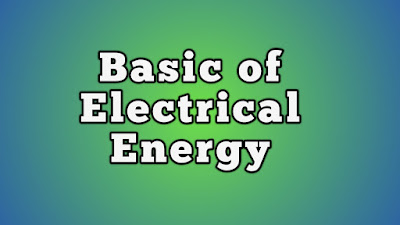Energy-Definition, Unit of energy, Relationship between different unit of energy
Details of energy, definition of energy, unit of energy, relationship between them
Definition of energy:
The ability or capability of a body for doing a work is known as energy. There are several kind of form of energy, but the most important ones are - 1. electrical energy, 2. mechanical energy and 3. thermal energy.
Now remember these energies are all interchangible.
Unit of energy:
Energy is a measurable quantity so we need to assign unit to energies, and as the energies are interchangeable so their unit should also have relation between them or same unit can be assigned because the energies are just in different forms.
1. Electrical Energy: The SI unit of electrical energy is watt-second also known as joule. Suppose there are two points which have a potential difference of 1 volt now a current of 1 ampere is flowing from one point to another.
So Power is equal to 1 volt * 1 ampere =1 watt.
Now if this continues for 1 second, then the energy consumed will be 1 watt * 1 second that is equal to 1 watt-second.
In case the system is AC then another factor called power factor comes into picture,
so, watt-second =1 volt * 1 ampere * power factor *1 second.
2. Mechanical Energy:
Unit of mechanical energy in SI system is Newton metre also known as joule. When a force of 1 Newton makes a body move by 1 metre distance then the work done on the body is 1 joule or 1 Newton metre.
3. Heat Energy:
Unit of heat energy in SI unit is joule. There are also other units that is calorie, British thermal unit or B. Th. U etc. Calories stands for the amount of heat energy that is required to increase the temperature of 1 gram water by 1 degree centigrade.
similarly British thermal unit can be expressed as the heat energy required to increase the temperature of one pound water by one degree fahrenheit.
Relationship between the unit of energy
All the three energies as mentioned above is convertible from one form to another, so their units are also have a relationship between them, and another thing is there to remember that all the three energies can do some work so they should have a common unit, and we can see that all the three energies have a common unit that is "Joule" now let us see the relationship between them.
Relationship between kWhr and Joule
1 kWhr (Unit)
= 1000 watt * 1 hr
=1*10^3 watt*3.6*10^3 sec.
=3.6*10^6 watt- sec= 3.6*10^6 Joule
Relationship between kWhr and N-m
1 N-m = 1 Joule
1 kWhr= 3.6*10^6 Joule
= 3.6*10^6 N-m
Relationship between Calorie and kWhr
1 kWhr=3.6*10^6 Joule
Again,
1 Calorie=4.18 Joule (Experimental value)
So,
1 Joule= 1/4.18 Cal
So,
1 kWhr= 3.6*10^6/4.18 Cal








